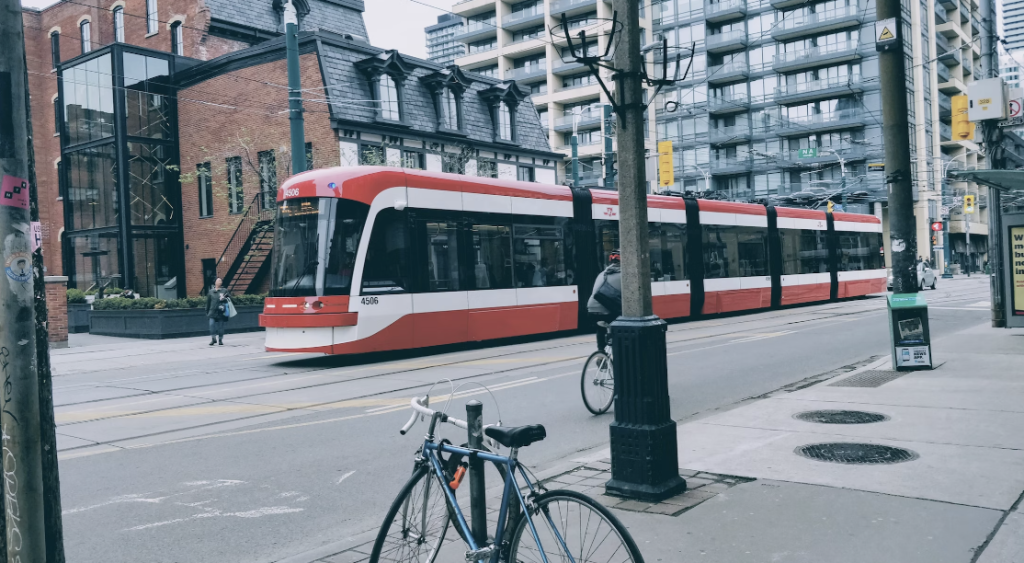
There are many ways to get to Skule™ in Toronto, whether you live uptown or if you rent somewhere far from campus. Here are some common methods of transportation, along with tips. You may want to plan out your daily commute before the term starts, so pay attention!
Biking
Do you know biking is often faster than driving downtown? Some students bike to school because it’s healthy, fast, and fun! Biking is also one of the more common options if you live close to downtown, since downtown Toronto has numerous bike lanes. However, if you’re commuting from further away and will be using public transit like the TTC along with biking, make sure to check their policy on taking bikes.
Be sure to check out the City’s guide to cycling in Toronto for information including maps, parking, laws, and integration with public transit. If you have not biked in the winter before, it is also worth checking out the City’s guide to Winter Cycling for safety tips. Lastly, for a list of bike shares, bike racks, and bike storage/parking, take a look at U of T’s Maps. Enjoy your rides and make sure to lock your bike!

If you have your own bike and are living in a residence (e.g., Chestnut Residence), bike rooms are available for storing your bike. Otherwise, Bike Share Toronto is also available 24/7, and their bikes are found across the city.
When it comes to bike maintenance, U of T has its own on-campus educational bicycle repair space, called Bikechain that offers a range of services from free bike rentals to do-it-yourself maintenance space.
Public Transit – TTC
The Toronto Transit Commission (TTC) runs subways, streetcars, and buses across Toronto, reaching into the York and Peel regions. The closest subway stations to campus are Queen’s Park, Spadina, Museum, and St. George, depending on your exact destination.
Queen’s Park is ideal if you have morning classes, especially in Engineering buildings like Sandford Fleming (SF), Bahen (BA), and Myhal (MY). It’s about a seven-minute walk from Queen’s Park to the EngSci Common Room in BA, according to Google Maps. If you’re heading to the Athletics Centre for a workout or to physics classes in the McLennan Physical Laboratories (MP), Spadina station is the nearest. If it’s exam season and Robarts Library is your destination, St. George is usually the best choice.

Lastly if you’re looking to enjoy a sunny day with a run around Queen’s Park, Museum station is perfect. (Can you tell that one of your blog admins has put way too much thought into optimizing their commute route?)
A single ride on the TTC is $3.35 if you are paying cash, and $3.30 if you are paying with a PRESTO card or your debit/credit card. If you do have PRESTO, there’s a two-hour transfer period, meaning you can enter the TTC unlimited times for free within two hours of the first tap (you do not need to tap when you exit). Check out the TTC website for the latest information on fares and passes.
If you will be taking the TTC regularly, you may want to buy a PRESTO card at customer service outlets, where you can also set up a student or youth discount. You can find details on how to get a Post-Secondary Monthly Pass here which offers unlimited travel on the TTC for a month for $128.15.
Note: Do your own calculations to see if a monthly pass will save you money based on the average number of rides you take on the TTC per month.
GO Transit
Go Transit may be an option for you if you are commuting from farther away within the Greater Toronto and Hamilton area. According to one of the blog admins, if you need to transfer between multiple public transit agencies, for example, the TTC, York Region Transit, MiWay, etc., or if your commute is longer than 2 hours using the TTC, it may be worth looking into the available Go Transit routes. With Ontario’s new One Fare Program, you can transfer for free between some of these agencies with a two/three-hour transfer window.
If you take GO Transit to commute between home and U of T, you will usually transfer from Go to TTC at Union Station. When taking GO trains and buses, make sure to schedule your trips, because they usually come once an hour and you don’t want to be stuck at Union Station! To save time, you can get some light work done during the commuteon the top floor of the train, also known as the “Quiet Zone.” If you need to charge your devices, accessibility coaches usually have functioning AC outlets.
You can use your PRESTO cards to pay for GO Transit as well. Unlike TTC however, GO Transit has a ‘Presto Monthly Savings’ system where your single ride fare in any given month depends on how many trips you have taken that month. You can use the GO Transit Fare Calculator here to find out the price for your commute and details about the monthly savings system as well. Similar to TTC, GOTransit also offers discounts to post-secondary students – check out details on applying for a GO Student ID here.
Walking
Many who live in residence or rent nearby choose to walk to school. If you are an international student, you should familiarize yourself with Toronto signals and laws, which may be different from what you are used to.
When walking to school, you should also take more precautions during the winter, especially if you aren’t used to snow yet. Sidewalks can be slippery, and concussions are no joke. Vehicles also take longer to stop on icy roads, so give them lots of room. You should walk more slowly and plan your commute accordingly. Dress accordingly, because you will be spending a short while outdoors.
Tips for Commuting
Students commute from various places around Toronto, so here are some tips for how you can make the most out of your commute!
You will be carrying your backpack around most of the day, so pack light and avoid bringing extra things that are available on campus, e.g., scrap paper. Pack a healthy and filling lunch/dinner and bring some snacks. If you do not feel like bringing your own lunch every day, there are commuter meal plans available from U of T Food Services.
You can rent lockers in the common room from EngSci Club (as well as multiple other locations on campus), so you will not have to carry everything back home and back to school again. With the extra space, you will have access to items such as chargers, stationery, and extra clothing without having to carry them.
Check to see if a monthly pass is cheaper for you. Make sure your Presto card is set up for a post-secondary student discount and remember to tap off when exiting GO buses and GO trains. You may want to download the PRESTO app so you can check your balance and load funds in advance. Better yet, set up autoload!
If you are taking public transit to get to class, check for service updates on their respective websites (TTC, Go Train, etc.) and always give yourself extra time to avoid delays or being late.
Aim to arrive at school at least 10-15 minutes before classes start. If possible, avoid rush hour (rush hour is generally from 8 am – 9am, 3 pm – 7 pm). And it’s always good to know alternative routes to get to your location in case of service changes or disruptions.
During midterms/exams, be sure to plan and arrive early. Before heading out, check ACORN to see if your exam is relocated because it can change at the last minute.
Prioritize your travel time, whether it’s listening to music, reading, studying or sleeping. If you choose to work during your commute, note that reading is easier than working on a problem set, for example, so plan accordingly. Make sure you can work (or relax!) offline, as Wi-Fi may not be stable.
Practice your time management skills. Schedule your travel time in your calendar or agenda, which will help you figure out how much time you have to complete schoolwork, study, partake in extracurriculars/hobbies, etc. If you plan for it, you can still be active in clubs and design teams as a commuter.
Outside of the commute itself, be sure to plan to get enough sleep. If you want to sleep before twelve, you should probably leave an hour or two before that, depending on commute time.
Additional Resources
For a thorough list of transportation services available to you, please check the U of T’s Transportation Guide. You can also use the interactive map of U of T here for details on all things campus-related from buildings, amenities to transportation, food, etc.
